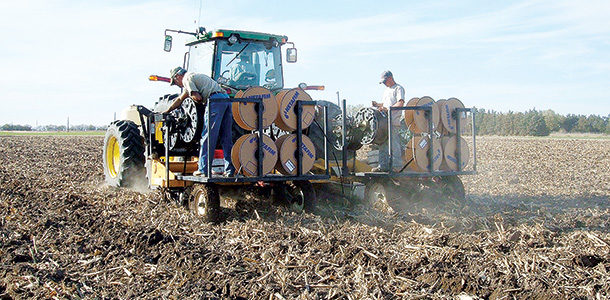Historically, the adoption of subsurface drip irrigation (SDI) in alfalfa production has been slow to catch on because of concerns about the initial cost of the system and the potential for rodent damage.
In the last few years, however, the use of SDI in alfalfa is on the rise, and growers throughout the U.S. are learning that with the right management practices, SDI in alfalfa can have a big impact on their production potential, and ultimately, their bottom lines.
Increasing yields
Alfalfa’s consumptive water usage can well exceed 46 inches each year. This fact, along with the opportunity to drive yield increases, is the main reason why growers are interested in using SDI in alfalfa.
A key benefit of irrigating alfalfa with SDI is the ability to irrigate during and immediately following harvest, allowing for rapid re-growth and resulting in more cuts and per-acre yields 25 to 40 percent higher.
With a recommended drip line lateral spacing of approximately 40 inches, and a depth between 8 to 12 inches, significant yield increases can be achieved by:
Less crop stress and faster re-growth post-cut – The faster re-growth is the result of irrigation uniformity and better water management, especially in the pre-cut drydown and post-cut curing process.

With flood irrigation, the non-irrigation period can be 12 to 16 days, whereas with SDI an eight-day to 10-day non-irrigation period is the standard. In sandy soils, the period can be shorter.
Increased forage tons per acre per cutting, even in hot summer months – The reduced stress on the crown from better water management results in lush vegetative growth and higher yields.
The yield increase is not accompanied by a decrease in quality because it results from vegetative growth and not woody-stem growth. Thus, quality is maintained along with higher yields.
The ability to quickly irrigate the entire block – For example, the ability to water an entire block within 24 hours of hay removal versus five to seven days with flood irrigation.
More profit
For alfalfa, a longer stand life means more profit. With drip irrigation, a grower may be able to increase stand life one to two years. Such increased stand life appears to be the result of better overall plant health due to more timely water and fertilizer applications.
Another contributing factor is reduced weed pressure due to the soil surface not being wetted, as with flood irrigation. Additionally, the slow wetting of the soil with SDI keeps large soil pores from filling with fine particles, thus improving aeration and reducing compaction.
Better returns
Managing irrigation in alfalfa with an SDI system provides greater opportunity to grow higher yields with less water. The return on investment depends primarily on the yield achieved, the price of alfalfa and the cost of water.
On average, the calculated payback is approximately two to three years.
Rodent management
Pocket gophers and other similar rodents can cause damage both to alfalfa crops and their SDI systems. While there is no single solution to rodent management in alfalfa, growers should utilize a layered approach to manage rodents to minimize impact on yields and SDI systems:
Site selection – Growers should set themselves up for success by selecting fields that do not have a history of unmanageable rodent pressure.
Site preparation – Growers should deep-rip the soil in preparation for planting and installing an SDI system. This practice helps to destroy burrows and disrupt the habitat gophers and rodents need for survival.
Predators – Recent findings in California by the U.S. Fish and Wildlife Service showed declines in pocket gopher activity following the installation of owl boxes in vineyards. Growers should expect these same results from nocturnal feeders in alfalfa.
Trapping – This can be effective in low population densities.
Poisons – Both baits and fuming toxicants are effective in treating hot spots. Burrow builders that create a burrow on the field’s edge are effective in intercepting gophers as they move toward fields. Growers are encouraged to protect the entire field edges with particular attention to riparian areas, ditch banks and adjacent fields. FG
PHOTOS
Subsurface drip irrigation systems are being installed with greater frequency as growers struggle to stretch shrinking water supplies. Photo courtesy of Brandon Souza.
Todd Rinkenberger
Western Region Sales Manager – Ag Division
Netafim USA
Advantages of drip irrigation in alfalfa
- Rapid regrowth from irrigation immediately following and even during harvest
- Reduced plant stress, which increases the yield per cutting
- Reduced intervals between cuttings, increasing the number of cuttings
- Fewer weeds because the soil surface is kept dry
- Longer stand life by managing irrigation to produce healthier root systems
- Improved uniformity of growth resulting in even windrows, better curing and an overall more efficient harvest










